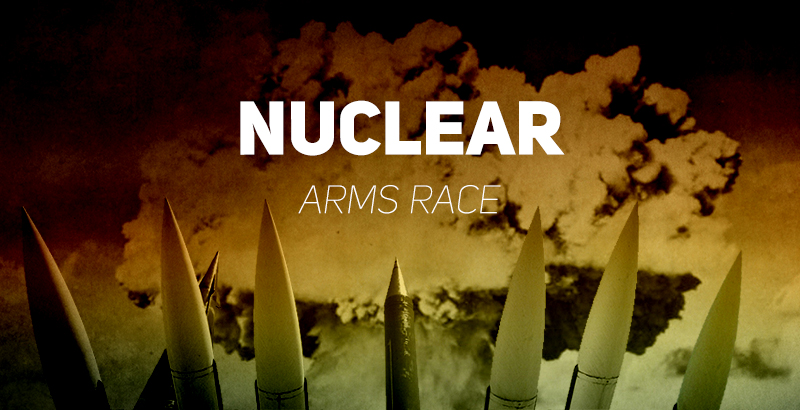
This analysis originally appeared at SouthFront in March 2016

The defense budget of the United States stands at roughly ten times the amount of its closest rival in real terms. With more than seven hundred military facilities around the globe, and direct and indirect armed interventions in a number of countries in the Middle East and Africa the armed forces of the United States are consuming vast amounts of money. When one adds in the significant amounts of waste inherent in the military industrial complex, the grand scale of the Department of Defense budget for 2016 in the amount of $521.7 billion has still left military planners and defense industry lobbyists bemoaning it as insufficient.
It has recently been argued that the advancements and achievements by both Russia and China in modernizing their military capabilities over the past decade have caught the U.S. military establishment off guard. This is up to debate; however, the fact remains that the only real potential adversaries of the U.S. have exponentially improved their military forces, mainly in the area of missile and aircraft capabilities, but also in the area of naval power projection and nuclear submarine deterrence over the past decade. The conventional military forces of both nations have been greatly improved in all respects.
In light of the United States losing its edge conventionally, many would assume that the U.S. could always fall back on its nuclear deterrence capability. This is also proving; however, not to be a suitable strategy as the U.S. has invested very little in this area of defense over the past half century. China has fielded indigenously designed and manufactured SSBNs to add a viable third leg to its nuclear triad in only the past five years, while Russia has greatly modernized its silo and mobile ICBMs, as well as fielding advanced electronic warfare systems over the past decade. The United States has apparently decided to utterly neglect its own nuclear capabilities since the dissolving of the Soviet Union. The U.S. defense establishment is now faced with not only the major challenge of modernizing its nuclear deterrence capabilities, but also where to find the vast sums of money required to accomplish this feat.

At the beginning of 2015, the U.S. Congressional Budget Office estimated that it would cost approximately $348 billion (USD) to upgrade and maintain all components of the nuclear triad. Eight months later in August 2015, the Center for Strategic and Budgetary Assessments estimated that it would cost $700 billion to maintain the current nuclear deterrence posture with necessary modernization and improvement over the next 25 years. In order to catch up on all the necessary upgrades and improvements/replacements of nuclear weapons, both air and sea based delivery systems and the command and control elements that manage them all, costs will hit annual levels of $30 – $35 billion starting in 2025 and lasting to at least 2036 according to the best estimates.

The above estimates assume that spending on the nuclear triad will remain between 3% and 5% of total defense spending, or in other words at traditional levels. A figure of $30 billion annually on the nuclear arsenal would thus yield a total annual defense budget of $600 billion. The 2017 proposed budget already stands at $582.7 billion, including an overseas operation contingency of $58.8 billion. As defense budgets have ballooned since 2001, the defense establishment has become accustomed to having large budgets. This has led to a culture of want, waste and the misguided allocation of funds to weapons programs that have been long on spending and short on performance. The Joint Strike Fighter and Littoral Combat Ship programs are prime examples.

At a glance, the U.S. nuclear triad seems quite robust, but upon closer inspection it becomes apparent that most of the weapons and delivery systems that comprise it are in desperate need of modernization. From the weapons themselves, both ICBMs and cruise missiles, to the aircraft and naval vessels meant to deliver them, most have been in service for over 30 years, some more than 60 years. Although these systems have been constantly updated, they are still based on designs that originated between the 1950s and the 1970s.
ICBMs, Bombs and Cruise Missiles
The only ICBMs land-based in silos within the United States are the 450 units of LGM-30G Minuteman IIIs. The Minuteman class of ICBMs was designed and manufactured between 1962 and 1970. The Minuteman III has a 170 kiloton yield, which is not high by ICBM standards, but it was significantly the first ICBM to utilize Multiple Independently Targetable Reentry Vehicles (MIRVs) making interception more difficult. The Minuteman III is slated to remain in service through 2030.

Minuteman III test launch
The submarine based deterrent utilizes the Trident II submarine-launched ICBM. The original Trident I (C4) was first deployed in 1979, with the Trident II (D5) following it into service in 1990. The Trident II is carried aboard the fourteen Ohio Class SSBNs is service with the U.S. Navy, and were designed with a 30 year life span to match the vessels. This means that they have a planned deployment until 2027; however, a life extension program was deemed necessary and Lockheed Martin was awarded the D5LEP contract in 2007, with the first upgraded Trident II being test fired from the USS Tennessee SSBN-734, in 2012.
The aircraft launched bombs and cruise missiles of the U.S. nuclear arsenal date from the 1950s and 1970s. The B61 bomb was originally designed in 1961, and has gone through an upgrade as recently as 2012. The B61-Mod12 was tested in 2015 and will increase the life of this free fall bomb by 20 years. The B83, which was designed in 1983 is also still in service. While designed in the 1970s, the AGM-86B nuclear cruise missile went into service in 1980 with over 1,700 units produced. The AGM-86B is an Air Launched Cruise Missile (ALCM) that was designed to be launched by the B-52 Stratofortress, which can carry a total of 20 of them. The ALCM gave the bombers some stand-off capability, and the high number of missiles per aircraft increased the probability of the missiles overwhelming the Soviet air defense capability of the era. Both the AGM-86B and the B-52 Stratofortress are still the backbone of the airborne leg of the U.S. nuclear triad.
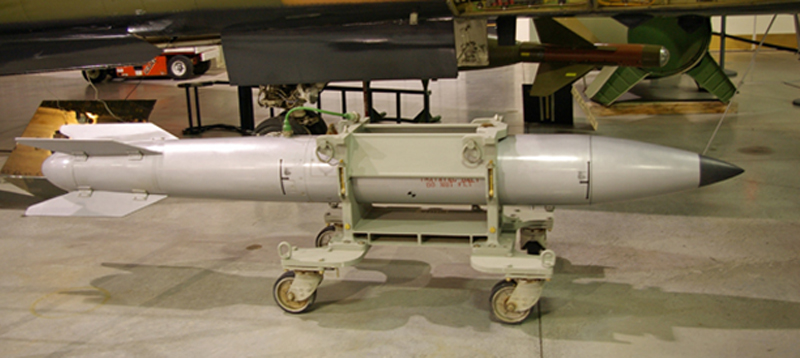
B61-Mod12 Nuclear bomb
Strategic Bombers
The United States relies heavily on the venerable B-52 Stratofortress as the main component of its strategic bomber force capable of delivering nuclear bomb and cruise missile attacks in the event of a nuclear confrontation. The B-52 has been utilized as a nuclear deterrent and as a conventional bomber since it first entered service in 1955. It is the longest serving strategic bomber in the world today, with the Russian Tu-95 Bear following closely behind by only one year. The B-52 has gone through a number of life extension programs over the course of its 61 years of service; however, it is still an aircraft that was designed in the 1950s. With no viable replacement, it is expected to serve well into the 2040s.
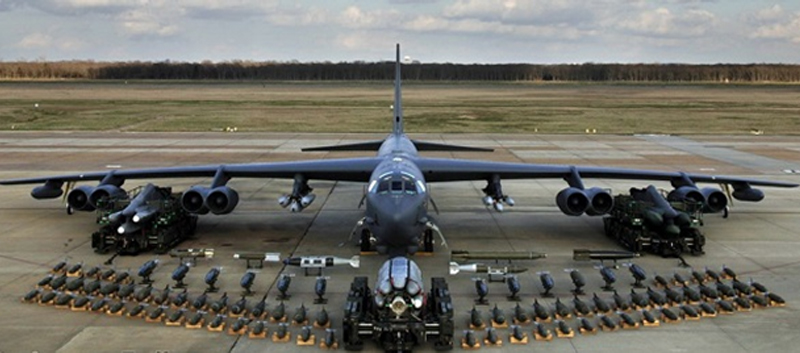
B-52 Stratofortess with available payload options. Still impressive after 61 years of vigilant service
The Boeing/Rockwell B-1 Lancer supersonic bomber was designed to penetrate Soviet air defenses at high speed to deliver both nuclear bombs and cruise missiles. A total of 66 of these aircraft are currently in service, having been converted to a conventional bombing role after the Soviet Union dissolved in the early 1990s. The B-1B was designed in the 1970s and largely produced in the early 1980s. It has been upgraded and modernized numerous times over the intervening decades and is currently undergoing a $1 billion plus upgrade to its communications and radar capabilities.
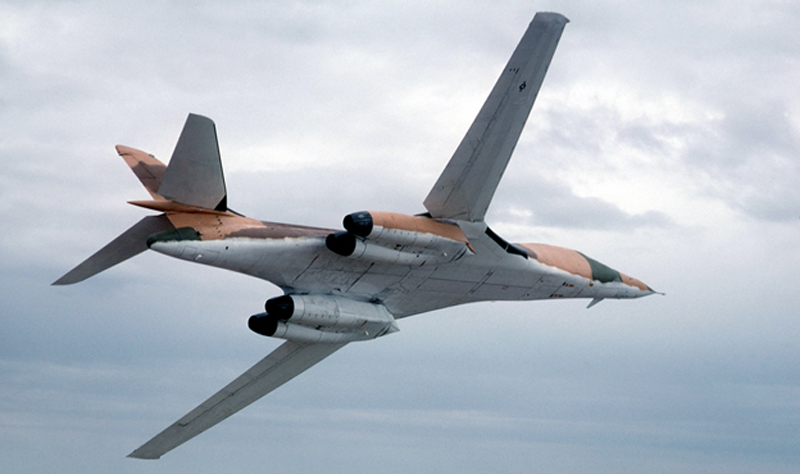
B1-B “The Bone” at cruising speed with variable swept wings extended
The Northrop-Grumman B-2 Spirit stealth capable bomber rounds out the U.S. strategic bomber arsenal. Developed in the late 1980s and first entering service in 1997, the B-2 was quite controversial at the time due to the high cost of the program. A total of 21 aircraft were built, with a total cost of approximately $45 billion. This seems almost laughable today, considering the $1.3 trillion that has been dumped into the B-35 Joint Strike Fighter program that still has yet to yield significant results.
Although quite capable when it was initially utilized, the stealth capabilities of the B-2 have been compromised over time, with the advent of much more capable air defense radars by the Russian and Chinese militaries. The B-2 would have a negligible effect in any conventional role against either of these potential adversaries due to their limited payload of 40,000 lbs. compared to the 70,000 lbs. payload of the B-52, and would thus most likely only be effective in a nuclear role today; however, the ability to deliver smart bombs against command and control and air defense installations must still be seen as a potential mission for this aircraft.
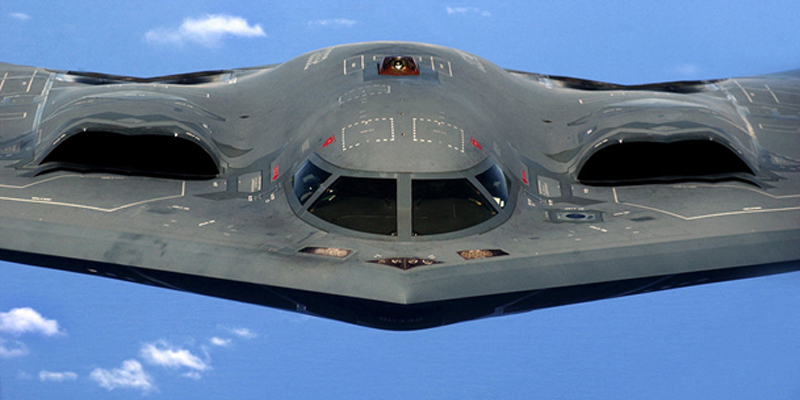
B2 Spirit stealth bomber seen from dead ahead
It has long been acknowledged that the venerable B-52, although stout and reliable, needs a modern strategic bomber to help it shoulder the load. The Long Range Strike Bomber (LRS-B) program, already awarded to Northrop-Grumman, envisions a totally new aircraft that is capable of delivering both conventional and nuclear payloads over unlimited distances (with in-air refueling) while remaining undetected with next generation stealth technologies. The Pentagon’s estimate of a total budget of $55 billion, with an initial operational date beginning in 2025 seems very optimistic compared to other high profile aircraft procurement efforts in recent years. The Joint Strike Fighter program has already racked up $1.3 trillion and has produced very little. Especially considering that the U.S. Airforce wants 80 to 100 aircraft, the initially estimate seems woefully inadequate.
Nuclear Submarines (SSBNs)
There are fourteen Ohio Class SSBNs in the U.S. Navy, designed with a thirty year life span. That life span is coming to an end starting in 2029 with the earliest commissioned boat the USS Ohio. The last four Ohio Class submarines were converted into guided missile submarines (SSGNs) and carry approximately 154 Tomahawk cruise missiles and a number of Harpoon anti-ship missiles.
The Ohio class SSBNs are highly capable vessels and have been conducting nuclear deterrent patrols since their introduction starting in the early 1980s. They carry a total of 24 Trident II ICBMs each, with the fourteen subs in class accounting for half of the active thermonuclear warheads in the U.S. active inventory. They were designed to provide the majority of deterrence in the nuclear triad, having the greatest ability to move undetected across the globe and to be able to remain submerged for years on end due to their nuclear power source. They are extremely quiet and carry a formidable nuclear and defensive conventional armament.
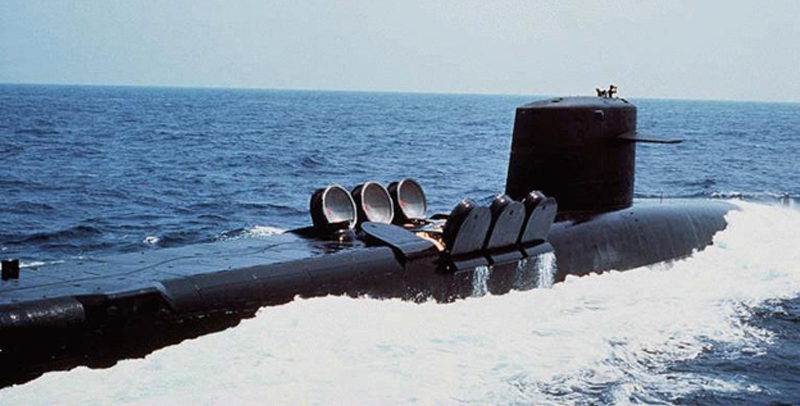
Ohio Class SSBN in the process of opening the Trident II missile launch bays
The procurement program to replace the fourteen Ohio Class SSBNs is known as the SSBN(X) program. Electric Boat and Newport News Shipbuilding were both awarded contracts to develop the next generation SSBN in 2007 and it is hoped that advanced levels of design and development of a viable replacement vessel will be a reality starting in 2017. Due to the required secrecy it is still yet to be announced whether the new SSBN will be based on the Virginia Class SSN, a revamping of the original Ohio Class or a whole new design. Only twelve units are planned to replace the existing fourteen boats. Interestingly, while each Ohio Class SSBN cost approximately $2 billion when originally procured, the first SSBN(X) will cost the U.S. tax payers $12.4 billion. It is estimated that once the initial investment in design and development in the first sub has been made, unit cost should drop to $5 billion per submarine, still 2.5 times the cost of the Ohio Class.

In considering the overwhelming importance of maintaining a viable and secure nuclear deterrent capability, and the significant costs associated, one has to wonder how the U.S. defense establishment has decided to spend the trillions that it has been allocated over the past decade. If the $700 billion figure put forth by the Center for Strategic and Budgetary Assessments listed earlier is taken at face value, could the U.S. government have allocated these funds years earlier, if it had been a priority, and catastrophic failures of foreign military adventurism had been avoided? The answer must be an unequivocal yes.
If the United States ruling establishment had truly been devoted to national defense and not misguided imperial adventures in the Middle East, Central Asia and North Africa, there were ample funds available, considerable technical expertise and a surplus of ability within the defense industry to modernize and improve the U.S. nuclear deterrence triad. Additionally, if only two misguided and failed military procurement programs are considered, the Joint Strike Fighter and the Littoral Combat Ship respectfully, it becomes readily apparent that the funds were available.
The Misguided Wars of Empire
Between 2001 and the current year, the United States Armed Forces have been engaged in combat operations of varying degrees in the nations of Afghanistan, Iraq, Libya, Yemen, Somalia and Syria. Covert operations are ongoing in various other nations of the world, as well as the current military patrols by the U.S. Navy in the South China Sea and the broader “Pivot to Asia” engaged upon by the Obama administration. When discussing the viability of military expenditures required to accomplish a modern and robust nuclear deterrent, past and current military operations must be taken into account.
The all-encompassing “War on Terror” has conservatively cost the citizens of the U.S. almost $2 trillion dollars since 2001. The Mercatus Center citing the Congressional Research Service has concluded that the “War on Terror” cost the U.S. approximately $1.68 trillion between the years of 2001 and 2014. As the graph below shows, most of this cost was directly attributable to the Department of Defense. A bare fraction of the total went to Veterans Administration efforts to manage the medical and psychological needs of the veterans of the conflict(s).
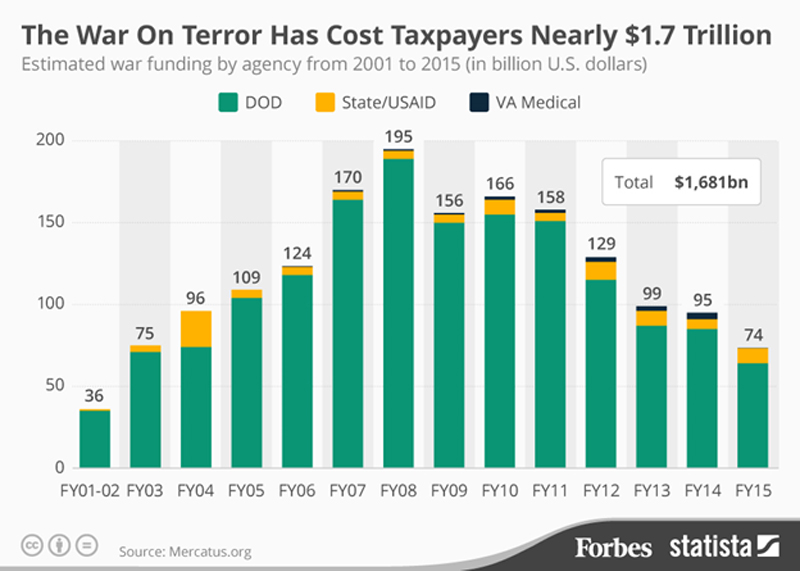
A mere tertiary review of the economic costs of the misguided and mismanaged wars of the United States on global “Terrorism”, which that same government created, funded and supported in so many of its varied forms over a period of 37 years mostly in the Middle East and Central Asia, reveals that the U.S. government squandered the blood and treasure of its citizenry on a grand scale. The wars of “Pax Americana” in the words of former Vice President Dick Cheney, wars of imperial hegemony cloaked in the legitimacy of combating global terrorists of every stripe, ideology and creed have in very real terms materially robbed the United States of a very sensible and credible nuclear deterrent defense.
The JSF and the LCS Failures
The two highest profile examples of defense establishment waste in U.S. history, are undoubtedly the Joint Strike Fighter and Littoral Combat Ship programs. At the most basic of levels the military practicality of both programs was questionable from the start, with both programs being controversial from their inception for a number of reasons. Many members of the Armed Forces, the U.S. Congress and military industry experts questioned their feasibility early on, and as the price tag mounts and the results continue to disappoint, their warnings and objections serve as stark warnings of the waste inherent in any fascist (merger of corporate and government) system. National defense suffers while the military industry, lobbyists, insiders and members of Congress reap economic benefits totally divorced from a viable national defense posture.
The Joint Strike Fighter program was arguably a failure from its conceptual origins. Never in the history of air warfare, has one aircraft design ever been able to meet the needs of all intended uses. This holds true over the century of air warfare experience and historically established doctrine, and yet the JSF was conceived with the very notion that one aircraft could perform all tasks. The JSF was intended to provide the U.S. Navy, Marine Corps, and Airforce with one platform that could meet all of their specific needs with minimal alteration and maximum rationalization of main airframe and parts. A rate of 70% commonality was called for, yet now it is estimated that there is roughly only 15% commonality of parts between each version of the aircraft. The cost of the program has ballooned to an estimated $1.3 trillion over the past decade, and the aircraft has yet to reach initial operational capacity (IOC). IOC requires at least one squadron of aircraft is fielded with the requisite trained pilots that can carry out the tasks assigned to the aircraft in question.
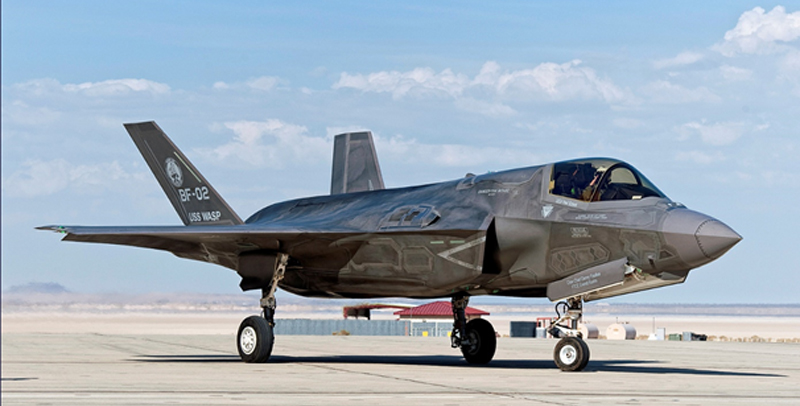
F-35 Lightning II Joint Strike Fighter
The JSF F-35 Lightning II is a failure in many respects. It has been out fought by an F-16 in dogfighting trials, its software glitches render its target acquisition radar and flight controls non-operable intermittently, its cockpit glass inhibits proper pilot visibility, not to mention it’s per unit cost has increased to the point that the Airforce will have to cut its operational squadrons by 20% in order to afford to field the fighter. The JSF program price tag continues to increase with no end in sight.
The Littoral Combat Ship (LCS) program is the U.S. Navy’s big debacle of the past decade. Designed to provide both the littoral capabilities of traditional small naval combatants such as the frigate and corvette with the fire support power of the battleship in support of landing forces and land forces operating close to littoral waters, the LCS was perhaps as doomed to failure as a naval concept as the JSF was in air warfare. Over the course of development, two competing LCS designs were approved by the U.S. Navy, the Austral USA Independence Class and Lockheed Martin Freedom Class designs being accepted, with an initial order of ten vessels per class.
Both vessel designs have failed to meet their design parameters and capabilities. They lack the surface combatant capabilities of a frigate as far as speed and maneuverability, lack the fire support capability of battleships for certain, and have fallen woefully short of promised AWS or ASW capabilities as well. In addition, the Lockheed Martin battle management system and phased array radars do not mesh with the AEGIS standard of all other U.S. Navy vessels and aircraft. The LCS vessels cannot speak the same language so to speak, as all other U.S. Navy assets. This problem, seven years after the first vessel was launched has yet to be rectified. Neither design has even been able to meet the operation range requirement set out by the Navy of 3,500 nautical miles at 14 knots, achieving only 2,000 nautical miles at this speed. The cost per unit of both designs stands at $1.8 billion today, up from an official 2010 U.S. Navy budgeted amount of $490 million.
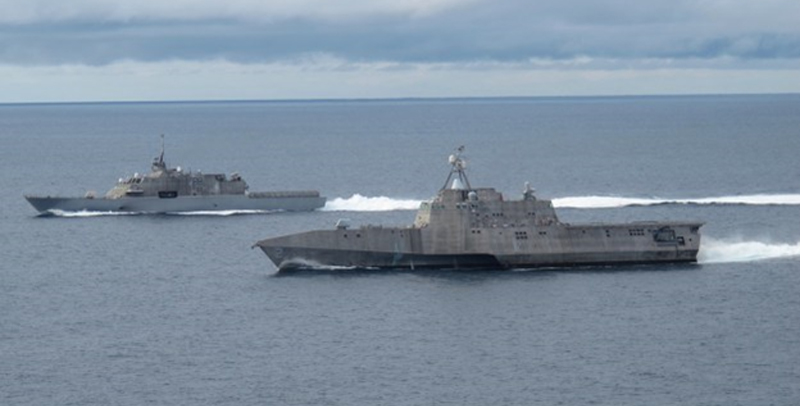
LCS USS Freedom and USS Independence at sea

As the preeminent power in the world, though waning in influence in all respects, it would seem logical that the United States government would hold its nuclear deterrent capabilities as the quintessential aspect of any viable national defense strategy. Yet it is obvious that this is not the case, that the defense establishment has woefully allowed this defense capability to erode and age to a level that is unacceptable. A strong nuclear deterrence is perhaps more in need now than at any time since the height of the Cold War.
Although the costs of modernizing and revitalizing the U.S. nuclear deterrent triad are significant, they are not outside the realm of feasibility, if a number of wasteful military programs and harmful overseas endeavors are halted in short order. The JSF and LCS programs were doomed to failure from the start, and have proven to be bottomless pits of military industrial complex waste at a grand scale. The U.S. tax payers deserve better. The U.S. warfighter tasked with defending his/her homeland deserves better.
If national defense is truly the aim of the Department of Defense, as it should be, then a major effort must be made to modernize and revamp the U.S. nuclear defense capability. This will require the abandonment of the current wasteful and harmful international defense posture that has U.S. soldiers, sailors and airmen stationed all over the globe, engaged in a contrived and unwinnable war against “international terrorism” , the ending of wasteful defense industry weapons procurement programs, and the adoption of a rational and logical national defense strategy. Profit, politics and imperial ambition must once again yield to classical liberal ideals of a republican nation-state living in an open and yet vigilant harmony with the rest of the world. These United States of America can and must regain their rightful place amongst the nations of the world, inspiring the world with its ideals of liberty, conspiring against no one and yet maintaining a vigorous and robust defense against any transgressors that aim to harm her.





